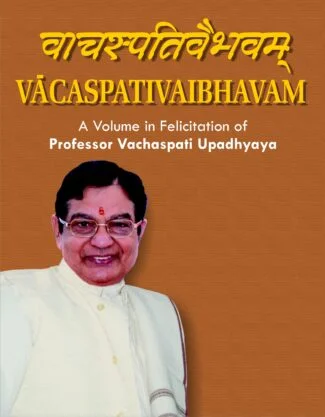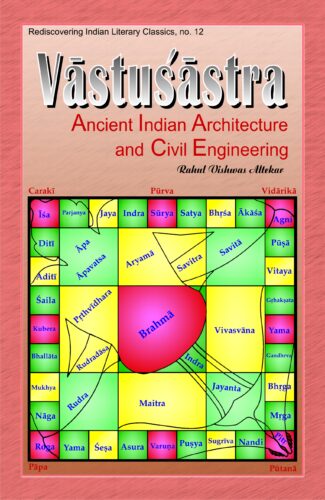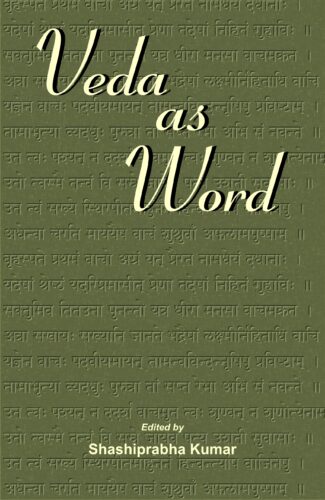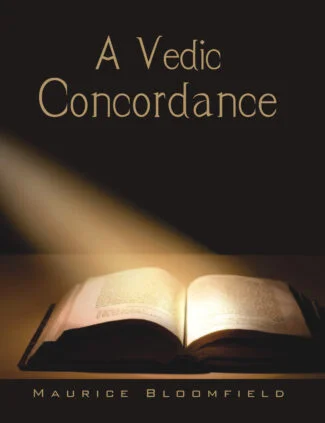Showing 121–132 of 136 results

This work presents a study of the twelve principal Upanisads, thus unfolding the spirit and substance of Upanishadic thought. It offers the text of the Upanisads in Devanagari and its translation in English along with detailed notes incorporating the commentaries of prominent spirit-ual thinkers and teachers including Sankaracarya and Sankarananda.
The Upanishads are perhaps one of the oldest philosophical treatises concerned with the mystery of the Absolute. This work (in three volumes) presents a study of the twelve principal Upanishads , thus unfolding the spirit and substance of Upanishadic thought. Written in a lucid style, it offers the text of the Upanishads in Devanagari and its translation in English along with detailed noted incorporating the commentaries of prominent spiritual thinkers and teachers including Shankaracarya and Shankaranand. The authors, scholars who have put in years of intense study on the subject, here offer a fresh approach and new insights into the philosophy of absolute unity as taught by the Upanishads and its quest for answers to abstruse questions like the origin of the universe, the nature of deity and the soul, and connection of mind and matter. The volumes are a must for scholars of Indian philosophy as well as students, and especially those genuine aspirants who wish to achieve moksha by the process of yoga for moksha is not possible without understanding the meaning of the Upanishads.

Studying the meaning and significance of Sri Visnu Sahasranama, the book discuss the metaphysical nuances of each name, related concepts/terms and the origin of the sacred hymn. It shows how the text presents a picturesque account of the Supreme Reality.
The book offers an erudite commentary on the sacred text of Shri Vishnu Sahasranama, one of the most important hymns in the great corpse of Indian literature. Dr. Panduranga Rao, a scholar of repute, here makes a detailed study of the meaning and significance of the hymn a garland of thousand names of the Lord of the universe glorifying his qualities in an attempt to qualify the unqualified. Devoting a separate chapter for the analysis of each of the 107 verses of the stotra, he brings out the metaphysical nuances of each name with references from various sources and mentions the texts where the names occur. He explains related concepts and terms in an effort to present a wider understanding of the subject. He also studies the context in which the sacred hymn originated. The scholarly commentary reveals how the sacred text presents a picturesque account of the Supreme reality, Highest existence and Absolute bliss through graphic language and by adopting a photographic style of its own. The work, with a foreword by Dr. Karan Singh, will be extremely useful to all scholars of Indian tradition and literature as well as others who are interested in the recitation and understanding of Shri Vishnu Sahasranama.

An anthology of over 90 articles penned by the renowned Sanskritists and Indologists in order to felicitate Prof. Vachaspati Upadhyaya covers different domains of Indian intellectual tradition, emphasizing upon the dialectical depth and thematic width of Indian philosophy, religions and culture enshrined in Sanskrit sources.
Vacaspativaibhavam is a modest tribute to the dynamic persona of Professor Vachaspati Upadhyaya whose chequered career spans more than four decades. In this volume, an earnest endeavour is made to collect and recollect his significant contribution to the academic world, both as a scholar as well as an administrator.
The first part of this volume carries benign blessings of saints and scholars for the unbound showering of divine grace upon Professor Upadhyaya. Many messages by the dignitaries and copious compliments from well-wishers and friends of Professor Upadhyaya convey his unmitigated commitment to the core human values cherished in his heart.
The second section of the volume comprises rich reminiscences penned by a vast majority of his colleagues and students from all over the country. These memoirs, in the form of personal reflections, are richly expressed through the medium of poetry and prose, and reveal the various aspects of the multifaceted personality of Professor Vachaspati Upadhyaya.
More than ninety research papers included in the principal part of the volume are not limited to the narrow compartmentalization of a particular subject but cover different domains of Indian intellectual tradition. Authored by a galaxy of scholars, Indian and foreign, these articles not only highlight the new ventures in cross-disciplinary studies, but also emphasize their basic concern with contemporary challenges facing humanity. The readers will relish that contributors to the volume have effectively reflected upon the dialectical depth and thematic width of Indian philosophy, religion and culture enshrined in Sanskrit sources.
In fine, the volume in hand promises to provide meaningful material for thought in the fields of Sanskrit and Indological Studies.
Vada, meaning debates, dialogues, discussions, was the quintessential of Indian spirit, enabling and promoting the growth of different philosophical and knowledge systems of India. It percolated deep into our mindset and enriched the moral, ethical, religious and sociocultural edifice of anything that was essentially Indian in nature. As continuation of Anvikshiki from the bc era, vada helped thrive Indian traditional knowledge systems. It subsists on diversity and its tradition envisages pluralism.
Most of our Sanskrit works, covering a wide gamut of knowledge systems, are structured in the techniques of debate. This reality applies not only to the philosophical writings, but to Indian medical systems (Ayurveda), Arthashastra of Kautilya and Kamasutra of Vatsyayana as well. Even great epics like Ramayana and Mahabharata are no exceptions.
Vada culture involved verbal duals, attacks and even violence of speech, and all major religious systems — old or modern — were parties to it. This book also elucidates how vata was vital and critical for the growth of our socio-political fabrics. It shows how some of the major conflicts in philosophical systems were centred around karma, jnana, choice between violence and non-violence, pravritti and nivritti. It also presents the manifestations of vada on a vast canvas during the nineteenth and twentieth centuries. Modern spiritual and religious gurus like Ramana Maharshi, J. Krishnamurti and Vinoba Bhave were men of dialogues. Our scholars have applied the varied techniques of vada against the philosophical and scientific systems of the West to prove them correct.
This collector’s issue should enthrall a wide audience of philosophers, scholars and believers in Indian knowledge systems.

This book deals with the basic rituals performed in religious rites related to Grihya and Smartakarma, and covers Samskara religious activities to be observed by the Brahmacàrins, marriage rituals, the duties of the newly-wed couples, domestic rituals, Sraddhakarma, Rajodharma, an elucidation of Gayatri-mantra the significance of Prana and Vyahritis and the mode of worship of Lord Vishnu and Shiva with Purushasukta.
The Vedhulagrihyagamavrittirahasyam of Narayana Misra is a versified commentary on the Vadhulagrihyasutravritti, which itself is a short commentary on the Vadhulagrihyasutra. It deals with the basic rituals performed in religious rites related to Grihya and Smartakarma. The text mainly deals with Samskara, religious activities to be observed by the Brahmacarins, marriage rituals, the duties of the newly-wed couples and several other religious and domestic rituals. The last two chapters deal exclusively with Sraddhakarma and Rajodharma, respectively. It includes an elucidation of Gayatri-mantra according to Acarya Sankara, the significance of Prana and Vyahrtis and the mode of worship of Lord Vishnu and Shiva with Purusasukta. The significance of Vadhulagrihyagamavrittirahasya is in not just what it contains but also in the fact that it refers to many unknown texts, such as Prayogaklripti, Katha-Aranyaka, Vadhulagam and Vrata Sangraha.

This book presents a lucid English translation of the Vaisesika-Sutra of Kanada, termed the earliest exposition on physics in Indian philosophy and the textual basis for the Nyaya-Vaisesika and Navya-Nyaya systems of thought. The translation retains the feel of the original sutras even while conveying the intended meaning accurately and with clarity.
Kanadas Vaisesika Sutra, the textual basis for the Nyaya-Vaisesika system and the later Navya-Nyaya system, may be termed the earliest exposition on physics in Indian philosophy. It presents one of the earliest discussions on the idea of atomicity and on the true nature of knowledge as comprising the categories of dravya (substance), guna (attribute), karma (action), samanya (generality), visesa (particularity) samavaya (inherence) and abhava (non-existence). This book presents the original Sanskrit text of the Vaisesika Sutra along with its Roman transliteration and a translation in the English language. The lucid translation is a scholarly attempt to retain the feel of the original sutras while conveying the intended meaning accurately and is easy to comprehend owing to many special features. Additional words are added in the translated text for the benefit of syntax but they are placed in parenthesis. The translated text has sub-titles that aid in simplifying the arguments by grouping the sutras. Besides, footnotes are provided to explain technical terms and concepts in the original Sanskrit. The book, published under the Shastra Group of Centre of Linguistic and English at Jawaharlal Nehru University which had earlier brought out the Yogasatra of Patanjali, will prove useful to all researchers and students of ancient Indian philosophy.

Examining vàstu÷àstra’s conceptual roots in øilpa÷àstra and its later evolution, the volume analyses technical aspects of vàstu÷àstra by concentrating on the essential elements (aïgas) of vàstu÷àstra which involve decision-making and actual construction methods, art of engineering and role and responsibilities of engineers, and aspects related to land materials and rituals associated with use of building after its construction
Though there has been considerable interest in vastushastra in recent times and the orientational aspects of vastushastra have been often discussed, little is known of the essential elements that constitute This small book, written in a simple and lucid style, contains teachings of great men, gleanings from the scriptures, and examples from the epics and Puranas, and suggests easy solutions to the various problems faced by man in the present-day world of violence, wars, killings and disasters, and how to have a holistic approach to life vastushastra and its scientific application in the present day. Based on extensive research, the work, vastushastra attempts to address this aspect. Examining comprehensively the subject of vastushastra: its conceptual roots in Shilpashastra and its later evolution as dealt with in the Vedas, the Epic literature, Arthashastra, literature on ayurveda and Kamasutra literature, the volume analyses technical aspects of vastushastra by concentrating on the essential elements [angas] of vastushastra which involve decision-making and actual construction methods, art of engineering and role and responsibilities of engineers, and aspects related to land materials and rituals associated with use of building after its construction. It discusses the eco-friendly life style of the ancient Indians based on vastushastra principles. Giving minute attention to details, it focuses on the application of vastushastra in the present-day society — how the vastushastra principles can be scientifically applied and the potential of application of vastushastra keeping in view modern trends in architectural science and civil engineering.
The book will be useful for students and scholars of architecture and engineering and those interested in vastushastra.

Examining vàstu÷àstra’s conceptual roots in øilpa÷àstra and its later evolution, the volume analyses technical aspects of vàstu÷àstra by concentrating on the essential elements (aïgas) of vàstu÷àstra which involve decision-making and actual construction methods, art of engineering and role and responsibilities of engineers, and aspects related to land materials and rituals associated with use of building after its construction
Though there has been considerable interest in vastushastra in recent times and the orientational aspects of vastushastra have been often discussed, little is known of the essential elements that constitute This small book, written in a simple and lucid style, contains teachings of great men, gleanings from the scriptures, and examples from the epics and Puranas, and suggests easy solutions to the various problems faced by man in the present-day world of violence, wars, killings and disasters, and how to have a holistic approach to life vastushastra and its scientific application in the present day. Based on extensive research, the work, vastushastra attempts to address this aspect. Examining comprehensively the subject of vastushastra: its conceptual roots in Shilpashastra and its later evolution as dealt with in the Vedas, the Epic literature, Arthashastra, literature on ayurveda and Kamasutra literature, the volume analyses technical aspects of vastushastra by concentrating on the essential elements [angas] of vastushastra which involve decision-making and actual construction methods, art of engineering and role and responsibilities of engineers, and aspects related to land materials and rituals associated with use of building after its construction. It discusses the eco-friendly life style of the ancient Indians based on vastushastra principles. Giving minute attention to details, it focuses on the application of vastushastra in the present-day society — how the vastushastra principles can be scientifically applied and the potential of application of vastushastra keeping in view modern trends in architectural science and civil engineering.
The book will be useful for students and scholars of architecture and engineering and those interested in vastushastra.

The present volume is a collection of papers originally presented at the first National Seminar held at the Special Centre for Sanskrit Studies, JNU, New Delhi, in February, 2005 on Veda as Word. The book covers Vedic philosophy, phonetics, ritual, accentology, mantravij¤àna, exegesis, narratives, lexicography, etymology, grammar, ethics, epistemology and some vedic hymns which deal specifically with word or sound.
The present volume is a collection of papers originally presented at the first National Seminar held at the Special Centre for Sanskrit Studies, JNU, New Delhi, during 11-13 February, 2005 on Veda as Word. The book covers in its gamut Vedic philosophy, phonetics, ritual, accentology, mantravijnana, exegesis, narratives, lexicography, etymology, grammar, ethics, epistemology and also some select hymns of the Veda which deal specifically with word or sound.

The Vedanta Sutras of philosopher-poet Narayana Guru has 24 beautifully-fluent sutras revealing the essential message of the Vedanta. The highly-perceptive commentary by Swami Narayana Prasad elucidates the gurus interpretation of the Vedantic concept.
Indias wisdom, one may say, attained its maturity in the Vedanta the end or culmination of veda (knowledge). Vedanta may be seen as the finest fruit on the tree of Indias wisdom, for it brings the seeker that ultimate knowledge that ushers in the gift of self-fulfilment (ananda). Over the centuries, brilliant saint-scholars like Shankara, Ramanuja, Madhva have interpreted the Vedanta in different ways. The philosopher-poet Narayana Guru belongs to this class of noted exponents of the Vedanta. And his Vedanta Sutras is a masterpiece in his attempt to restate the original Upanishadic teaching of non-dual Reality his most succinct expression of that message. This book presents these sutras along with a highly-perceptive commentary that elucidates the Gurus interpretation of the Vedantic concept in a brilliant style. Narayana Gurus Vedanta Sutras reveal the essential message of the Vedanta in 24 beautifully-fluent sutras. His simple and direct revaluation and restatement of the Vedanta, in general, has been found to be comprehensive and contemplative in its insight, reconciling the superficial disagreements of the Vedantic schools and restoring the pristine vision of the Upanishadic sages. In this scientific age, his work has often been acclaimed for its relevance. His Vedanta Sutras, compact yet profound in manner, is yet another example of this. The thoroughly-engrossing commentary of Swami Muni Narayana Prasad is a unique effort. Its hallmark is his clear avoidance of exegesis with greater reliance on his personal conviction. Swami Muni Narayana Prasad places Narayana Guru on par with the sutrakaras like Badarayana, Jaimini, Gautama and Kanada with this beautiful elucidation.
This volume explains the mysteries of Creation from the Vedic standpoint by an eminent scholar Pandit Motilal Shastri, a devout disciple of the much acclaimed Vedic guru, Paṇḍit Madhusūdan Ojhā. It consists of five scholarly discourses presented before an august audience of well-known scholars and ācāryas of Vedaśāstra, at Rashtrapati Bhawan during 14-18 December 1956. These discourses – Science of Agni-soma; the Science of Five Divisional Universe; Vedic Concept of Man: An Exposition; Science of Aśvattha: An Outline; and Integrated Relationship of Vedaśāstra and Purāṇaśāstra – illuminate new insights into the mysteries of Creation, offering new definitions to well-known Vedic terms. The volume in hand is an English translation of these five discourses by Rishi Kumar Mishra, a well-known author, writer and editor, and a disciple of Pandit Motilal Shastri. It enables the new generation of scholars and intellectuals to understand and grasp the mysteries of Creation. It is an inimitable storehouse of Vedic wisdom.

This volume, originally published in 1906 as part of the Harvard Oriental Series, is an alphabetic index to every line of every stanza of the published Vedic literature and to the liturgical formulas; it is an index to the Vedic mantras, together with an account of their variations in the different Vedic books.
This volume, A Vedic Concordance, is part of the Harvard Oriental Series. This reprint of the 1906 edition is an alphabetic index to every line of every stanza of the published Vedic literature and to the liturgical formulas; it is an index to the Vedic mantras, together with an account of their variations in the different Vedic books.
This volume is expected to serve two purposes. 1. It gives a comprehensive index of all the mantras. 2. It registers the variants of mantras that are not wholly identical. In addition, it spells out few secondary uses. (i) It is a key to the liturgical employment of the mantras. (ii) It is virtually a finding-index of rites and practices. (iii) It is a tool for future editors of Vedic texts. (iv) It is a repertory of the most archaic Hindu prose. (v) It also provides some miscellaneous uses to the future researchers in the domain of Vedic studies and sciences.
A must buy for all universities, colleges, institutions, scholars, researchers, and students who are engaged in Vedic studies.
| There are no products |